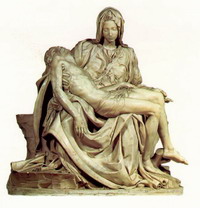Login form
Michelangelo
 Michelangelo was an artist of extraordinary ability. He is known primarily as an outstanding painter and sculptor, but he was also an accomplished architect and poet. He had a forceful personality as well.
Michelangelo was an artist of extraordinary ability. He is known primarily as an outstanding painter and sculptor, but he was also an accomplished architect and poet. He had a forceful personality as well.
HE LOVED A CHALLENGE
Michelangelo Buonarroti was born in Caprese, a village in Italy, in 1475. He grew up in Florence, the artistic center of Europe during the 1400s. At 13, he began to train as a painter.
Michelangelo believed that the nude (naked) male figure was the most important subject in art, and he loved a challenge. He preferred to create art that required hard work. For example, he carved blocks of marble that other sculptors had rejected, and he created enormous paintings on very high ceilings. In painting, he chose to put his figures in poses that were especially difficult to draw. In carving, he cut away the stone in a way that seemed to release a human figure trapped inside.
HIS BEST WORK
Michelangelo’s early sculptures made him famous. His Pietà shows the dead Christ lying in his mother’s lap. Michelangelo emphasizes Christ’s suffering through the limp, frail body that is cradled by the Virgin Mary. Michelangelo carved a huge statue of the biblical hero David. It shows the strong, young David calmly holding the slingshot he is about to use to slay the giant warrior Goliath. The city of Florence displayed the statue of David as a symbol of its political strength.
Michelangelo’s greatest challenge was to paint the gigantic ceiling of the Sistine Chapel in Rome. To paint the Sistine Ceiling, he had to lie on his back on a wooden platform high in the air. It took him nearly four years, but Michelangelo created some of the most memorable images of all time. The Sistine Ceiling tells the biblical story of the Book of Genesis. It begins with the creation of the world and finishes with the story of Noah. It contains almost 350 painted human figures, all of them larger than life-size.
Later, Michelangelo painted the Last Judgment in the Sistine Chapel, on a wall above the altar. This mural is filled with swirling nude bodies. Some rise from the grave to heaven. Others descend in agony to hell. Michelangelo’s greatest architectural work was a design for the dome of Saint Peter’s Cathedral in Rome.
Michelangelo died in 1564. He had an enormous influence on European artists of his time and on those who came after him. After Michelangelo, artists competed with each other in painting the human body in difficult poses.
Source: Microsoft ® Encarta

